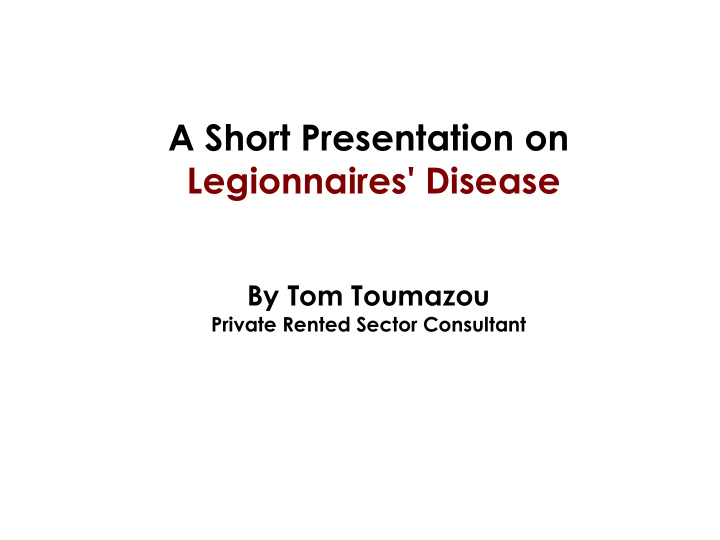



A Short Presentation on Legionnaires' Disease By Tom Toumazou Private Rented Sector Consultant
What is Legionnaires' Disease Legionnaires’ disease is a potentially fatal form of pneumonia caused by the legionella bacteria. Some people are at higher risk including over 45s, smokers and heavy drinkers, those suffering from chronic respiratory or kidney disease, and people whose immune system is impaired.
What is Legionella? Legionella are bacteria that are common in natural (rivers and lakes etc) and artificial water systems, eg hot and cold water systems (storage tanks, pipework, taps and showers).
Spread of Legionella Legionella survive in water and spread via an aerosol or fine spray into the lungs. Legionella survive in low temperatures thrive between 20 o C and 45 o C. High temperatures of 60 o C and over will kill them.
Legionella Disease Outbreaks We usually associate legionella with larger water systems, eg hotels, hospitals Belle Vue Hotel Philedelphia PA North Staffs Hospital Macfarlanes Factory South Wales Cooling Towers
Legionella Disease Outbreaks But They can also live in smaller water supply systems used in homes. Other potential sources of legionella include spa and whirlpool baths and fire-fighting systems (sprinklers and hose reels).
ACOP Legal Requirements Approved Code of Practice (ACOP) and guidance and guidance Legionnaires’ disease: The control of legionella bacteria in water systems Some important changes that could affect a provider of residential accommodation. You may have to assess the risk from exposure to legionella in your premises, and introduce appropriate control measures.
Legal Requirements in the ACOP Organisations, groups or self-employed individuals providing residential accommodation who are responsible for the water system(s) in premises, including: ● landlords in the private renting sector; ● managing agents; If a boiler, tap or shower head breaks/leaks who is responsible for getting it repaired? If it is you, then you need to be aware of the legal requirements in this guidance. You cannot delegate these responsibilities to a third party through an agreement.
ACOP Legal Requirements • Responsibilities of Persons Responsible • Identifying and assessing sources of risk, • Preparing a scheme to prevent or control risk, implementing, managing and monitoring precautions, • Keeping records of precautions • Appointing a manager to be responsible for others.
Complying with the ACOP Generally the high throughput and relatively low volume of water held in smaller water systems reduces the likelihood of the bacteria reaching dangerous concentrations. You must carry out a risk assessment to identify and assess potential sources of exposure. Introduce a course of action to prevent or control any risk you have identified. Keep records for a minimum of five years;
Assessing The Risk It should be possible for you to assess the risk yourself Consultants may be used Consider the following: ● Are conditions right for the bacteria to multiply, eg is the water temperature between 20 o C and 45 o C? ● Are there areas where stagnant water occurs (deadlegs), eg disused pipes? ● Are there infrequently used outlets, eg showers? ● Is there debris in the system, such as rust, sludge or scale that could provide food for growing legionella?
Assessing The Risk Consider the following: ● Are there thermostatic mixing valves that set a favourable outlet temperature for legionella growth? ● Are any of your employees, residents, visitors etc vulnerable to infection, eg older people, those already ill? Answering ‘yes’ to any of these questions suggests there is an increased risk of your residents being exposed to legionella and falling ill. If you decide the risks are insignificant review the assessment periodically.
If Risks Are Identified Introduce proper controls, this could include disinfection of the system Refer to the ACOP for guidance The design, maintenance and operation of the system are crucial, any action is likely to include the following: ● ensuring water cannot stagnate anywhere in the system, eg remove redundant pipework, run taps/showers in unoccupied rooms; ● keeping water cisterns covered, insulated, clean and free of debris; ● insulating pipework;
If Risks Are Identified ● maintaining the correct temperature at the hot water cylinder; ● advising maintenance staff about the risks; and ● advising tenants about the risks, the control measures and the precautions they can take, such as flushing through showers following a period of non-use. Note: raising the temperature of your warm water could also increase the risk of burns and scalding. You will need to consider points like this when you decide which control measures to use.
After Assessing Risks and Introducing Controls Review your risk assessment at regular intervals, especially if any factors change, eg you change your disinfection regime, more vulnerable groups of people (eg the elderly) move into your accommodation.
More Information and Guidance Legionnaires’ disease. The control of legionella bacteria in water systems. Approved Code of Practice and guidance L8 (Second edition) HSE Books 2000 ISBN 0 7176 1772 6 . An introduction to the control of legionella bacteria in water systems Video HSE Books 2003 ISBN 0 7176 2580 X ; You can also obtain advice from: HSE office and the HSE website (www.hse.gov.uk) Environmental Health Department Chartered Institution of Building Service Engineers (CIBSE) at www.cibse.org the Building Services Research and Information Association (BSRIA) at www.bsria.co.uk
Recommend
More recommend